Action photos are some of the most exciting ones that we can create. However, portraying action and motion is challenging and requires timing and skill. The first thing you must decide is how you want to portray movement. Some kinds of action are best expressed by freezing their peak moments. You may want to use a fast shutter speed so that every detail is very sharp — a basketball player suspended in midair, or a skateboarder at the peak of his upward momentum. However, at other times you may choose to blur your subject intentionally with a slow shutter speed to emphasize the feeling of motion. For example, you can open your shutter and allow subjects like dancers to move across your frame in a blur of color. Whatever way you choose to portray action, it's fun to experiment with a variety of shutter speeds, vantage points, lenses and styles.
Besides shooting the typical sports action, sometimes it's nice to capture special moments as this photographer did during a Little League game. A fast shutter speed froze the mud spraying from the catcher's mitt, and a long telephoto lens brought the action in close. When using such a long telephoto, sharp focus is critical. For this reason, many sports photographers use a monopod to steady their cameras. A tripod often gets in the way at busy sporting events. When capturing split-second action like this, it's a good idea to use your camera's motor drive or sports mode to shoot several frames rapidly.
"Shooting professional sports doesn't always allow you to be as creative as you would like to be. I bought a Youth Sports Photography dealership, which enables me to be as creative as I like and my clients enjoy the results. The mother of this athlete asked me to get some shots of her son during the inning when he was catching. I set up right behind the pitcher's mound and used the available South Florida sunshine. I knew from being a catcher myself that the clay would explode off the glove when the ball hit it. This particular day, the clay was wet, and it stuck to his glove and popped just as I hoped it would."
Canon EOS 1D Mark II digital SLR
Canon EF 500mm f/4.5 telephoto lens
1/1000 of a second at f/4.5
ISO 400
Ambient daylight
"Playing Catch"
© Jim Donnelly
Coral Springs, Florida www.ImageMastersPhotography.net
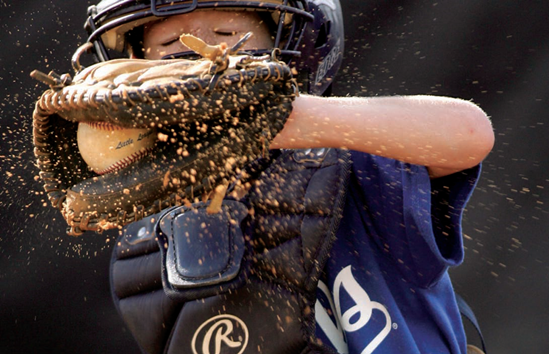
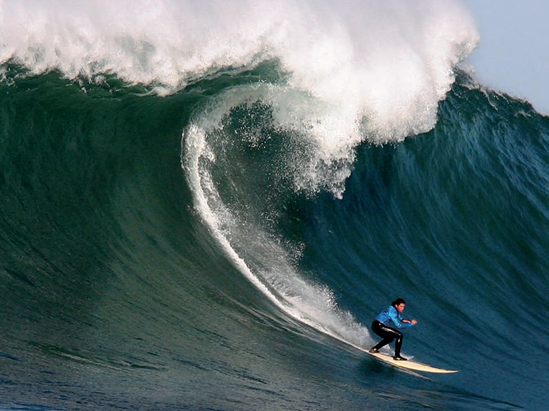
"Maverick Surf Contest"
© Michael Geib
San Ramon, California
Sports photographers usually rely on super-telephoto lenses to bring the action in close. But as this surfing photo attests, sometimes it's equally important to show an action subject in its environment. The photographer wisely included the wake of the surfboard, which leads the eye up to the froth of the wave above. He also froze the action with a moderately fast shutter speed. You can use a somewhat slower shutter speed (around 1/125) to stop action that's moving directly toward you than you need to stop action moving diagonally across the frame.
"When I retired, I had a list of things I wanted to do, and seeing the Maverick Surf Contest was on that list. To my surprise and delight, I was able to be on a boat for the first runs of the contest off the coast of Pillar Point, about 25 miles south of San Francisco. The contest is held about a mile offshore, and the contestants wear different color wetsuit tops to distinguish who they are for each 'heat.' It's up to each contestant to get as many good runs as they can during the allotted time for each heat. The leaders move on to the finals in the afternoon. Photography topped off a great day of being at this competition."
Canon EOS 20D digital SLR
Canon EF 70–200mm f/2.8 zoom lens with
Canon 1.4X extender
1/200 of a second at f/3.5
Camera handheld
Ambient daylight

"Parapsychology"
© Atle Garmann
Bergen, Norway http://atlegarmann.photoworkshop.com
One of the most effective ways to depict motion in an image is to follow a subject with your camera during a fairly long exposure. If the photograph is successful, you get a relatively sharp subject against a completely blurred background, as this photographer has achieved. You probably won't render your subject totally sharp, but a little blurring of the subject adds to the feeling of movement. When panning an image, try to choose subjects that are separated from the background, and look for bright backdrops that will produce an interesting color blur. Timing and smooth camera movement is critical when executing a panning technique.
"This image was taken during the extreme sport week in Voss, Norway. I wanted to shoot a panning technique where the background was so blurred you couldn't recognize what it was. These paragliders were landing at 136 km/hour, and I knew that by using a telephoto lens and slow shutter speed, I could get what I was after. I also wanted to avoid positioning the paraglider in the middle of the frame, but rather on the right side, so I could get the most blur behind him. The purple color in the background is actually a tent with blue and red vertical stripes. I only had two opportunities to shoot this image, and this was the second take."
Canon EOS 5 35mm SLR
Canon EF 75–300mm f/4–5.6 III zoom lens set at 75mm
1/20 of a second at f/32
Kodak Ektachrome 100 VS film
Ambient light on overcast day
Good timing on the part of the photographer accounts for the success of this image, which is another wonderful depiction of motion. The people are rendered in sharp detail in contrast to the blurred hounds that are rushing forth in this race, a great way to use motion blur. This technique recreates the way that fast-moving subjects appear to us. Again, your shutter speed will depend on how fast your subjects are moving, and in what direction. In this case, a shutter speed of 1/125 was just slow enough to render these fast dogs as a blur while they passed through the photographer's field of view. Shutter speeds below 1/30 will blur motion even more dramatically, but it will be more difficult to render the rest of the image sharp. The closer you are to your moving subjects, the more likely they will be blurred in an image.
"This photo was taken at the Grasmere Show, which takes place annually in the English Lake District. These hounds race each other over a course that begins at the show grounds, goes over several nearby fells (hills), and returns back to the show grounds. I chose this shutter speed to deliberately capture the forward motion of the dogs as they were suddenly released by their owners."
Canon EOS 20D digital SLR
Canon EF-S 17–85mm f/4–5.6 IS zoom lens set at 85mm
1/125 at f/5.6
ISO 200
Light overcast daylight
"Trail Hounds Released"
© Alex Stephen
Ayrshire, United Kingdom
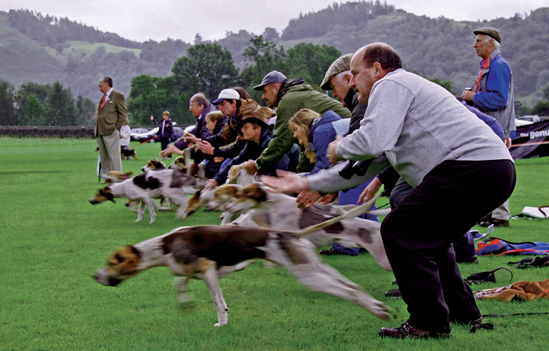

"Safe on Third"
© Dennis Guillaume
Elkhart, Indiana www.guillaume.com
One consideration when shooting sports is getting close enough to the action (either physically or via a telephoto lens). This photographer positioned himself as close as possible to third base. He also fired at five frames per second to freeze the perfect moment of this young baseball player sliding into third base. To stop motion, you need to use a fast shutter speed, which depends on your directional relationship and your distance from the action. You can use a slower shutter speed to stop action that's moving directly toward or away from you than you can use to stop action moving across your field of view. You may be able to freeze the motion of a baseball player running toward you at 1/125, but an athlete who's moving from left to right in the frame may require a speed of 1/1000.
"I was asked to shoot local little-league baseball action photos. This was a regular late-afternoon game with the sun over my shoulder, coming in at an angle. I positioned myself just outside a four-foot fence on the third base line just beyond the base bag. The advantage was being able to anticipate a steal or hit moving the runner from second to third and using a pre-set exposure. Following the runner from second base and firing at five frames per second yielded this shot."
Canon 20D digital SLR
Canon EF 28–300mm f/3.5–5 L IS zoom lens
1/400 of a second at f/11
ISO 400
Manfrotto 680B Monopod
Late afternoon sunlight
A very fast shutter speed and high ISO can enable you to freeze a moment of fast-moving action, like this wakeboarder suspended in midair. Even the spray from the wake below is rendered as frozen droplets. The necessary shutter speed to freeze action depends not only on the speed of your subjects, but also on their distance from the camera. Try a faster shutter speed for subjects that are large in the frame and relatively close such as a shutter speed of at least 1/1000. However you may be able to stop the action of a bicycler off in the distance with a shutter speed of 1/250. Try to anticipate the moment of peak action and click the shutter a split-second beforehand.
"This image was taken from the back of a boat during the annual Southern Plains Festival wakeboarding competition, held in Eufaula, Oklahoma. I have seen some of the most spectacular tricks, as they use the wake from the boat to launch themselves into the air, forming the most beautiful forms of art. The strength and determination that each of them bring to this event is inspiring to all."
Canon EOS 30D digital SLR
Canon EF 70–200mm
L zoom lens set at 98mm
1/2000 at f/4.0
ISO 200
Daylight
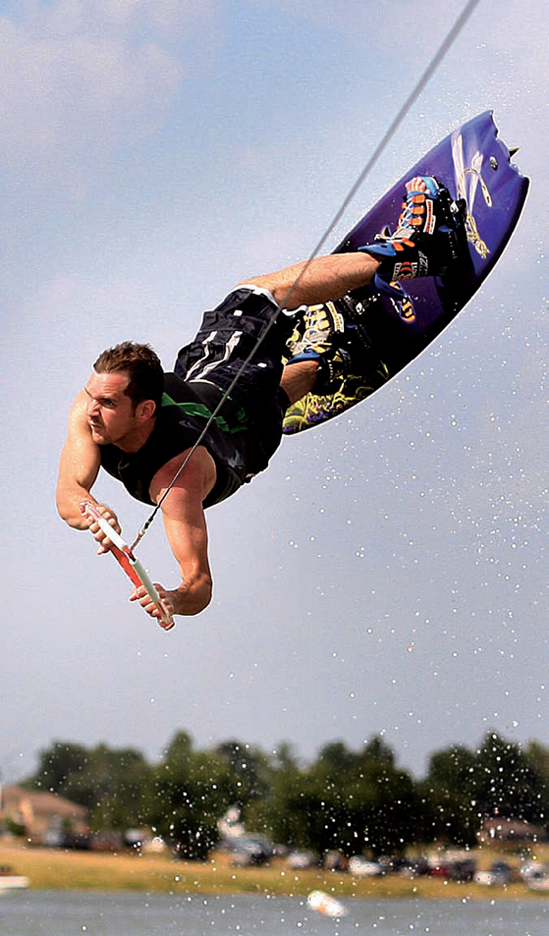
"Wakeboard"
© Lisa Butler
Tulsa, Oklahoma http://lisabutler.photoworkshop.com
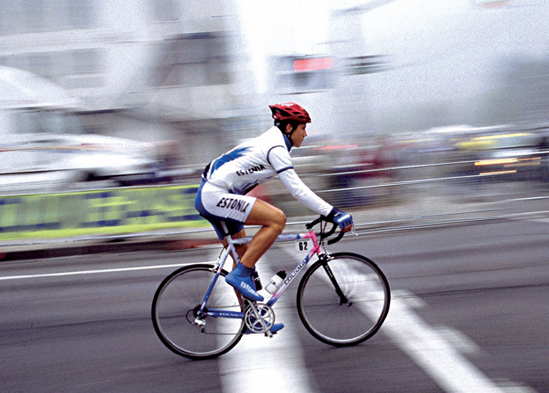
"Racer"
© John Wallace
Caledonia, Ontario, Canada
This image of a bicyclist is a good example of panning, which is a great way to infuse an image with a sense of motion. Follow the subject with your camera during a fairly long exposure. Choose a subject that's pretty well separated from its background, and try to find a background that will give you a pleasant blur of color. You've got to use a rather slow shutter speed — such as 1/15 or 1/30 — to pan a subject moving across your field of view. At shutter speeds slower than 1/15, use a tripod or monopod. For a successful panning technique, start following your subject before you click the shutter and continue to follow it after you hear the shutter click. And rather than moving only your head and shoulders, rotate your entire upper body in one smooth movement. Use a slow ISO of 100 or a neutral-density filter (which lets less light into the lens) to avoid overexposure on a sunny day.
"I took this image of a single rider heading to the start line of the World Cycling Championships, a major cycling event in Hamilton, Ontario. I wanted this image to show a sense of motion. By using a slow shutter speed and a panning technique to blur the background, yet render the rider sharp, I was able to portray the sensation of speed.
Canon EOS 3 35mm SLR
1/30 of a second (aperture not recorded)
Fujichrome Provia 100 transparency film
Daylight
A fast shutter speed is the key element in stopping action. In this image, the subject is frozen midway down this waterfall. The water is depicted in sharp detail; you can almost hear the thundering sound of these falls. A good stop-action photo requires planning. This photographer could obviously foresee the path that the subject would take and anticipated this shot. It's a good idea to pre-determine your vantage point, lighting, background and exposure in advance so that you can concentrate on your subject. Use the motor drive or sports mode on your camera to shoot several frames in rapid succession, and learn to click the shutter a split-second before the peak action occurs.
"This is a shot of my brother, Shaun Baker, who is the holder of four Guinness World Records for extreme kayaking. He's halfway down Godafoss (Waterfall of the Gods) in Iceland. We have spent a decade traveling the world to find kayaking challenges, but this remains one of our favorites. When shooting at these dangerous locations, I am very well aware that each shot may be the last one of my brother alive. This brings a lot of responsibility; I never want to be in a position where I put his life in additional danger by having to say, 'I missed the shot — any chance you can do that again?'"
Canon EOS-3 35mm SLR
Sigma 50–500mm f/4–6.3 zoom lens set at 500mm
1/400 of a second at f/6.3
Fujichrome Provia 100 transparency film
Manfrotto monopod
"Half Way Down"
© Darren Baker
Reading, England www.darrenbakerphotography.com
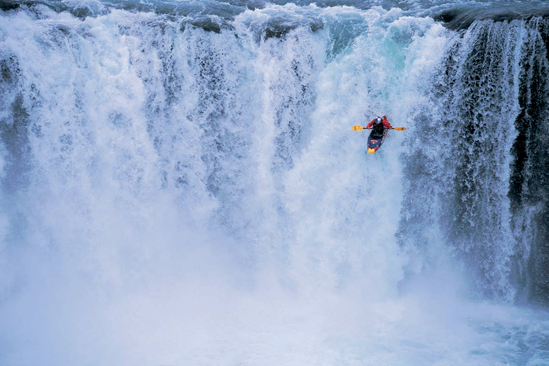
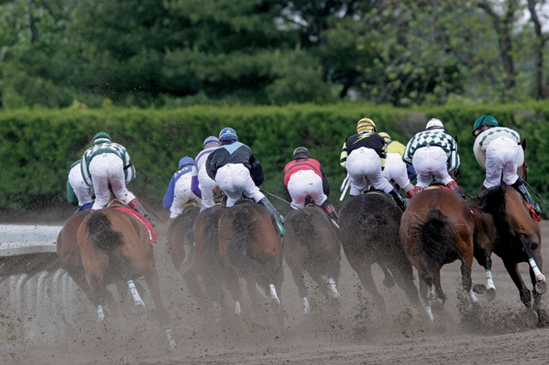
"Turn One"
© Peter Marney
Hoboken, New Jersey http://peter-marney.smugmug.com
Shot from a rear view, this image captures all the excitement of a horse race soon after leaving the starting gate. And with the motion heading away from the photographer, instead of moving across his field of view, a shutter speed of 1/500 was perfect for freezing these thundering hoofs and flying dirt. Again, a good stop-action photo requires planning on your part. Venues such as racetracks provide a predictable path where the action takes place, making it easy for you to decide ahead of time where you want to shoot, and to adjust your camera settings. This photographer also used a polarizing filter to saturate colors. This filter also deepens the blue of the sky on a sunny day.
"This image was taken at Monmouth Park Racetrack in New Jersey. I really enjoy photographing horses because of their natural beauty, whether it's racing, jumping, polo or any other event. Thoroughbreds are particularly competitive, so in this instance I really wanted to capture the charge for the lead heading into the first turn. The horses are bumping into each other in a mass as they approach the turn, as you can see with the three horses on the right. The flying dirt and cloud of dust helps to convey the action and high speed as each jockey tries to lead his horse into the winner's circle."
Canon EOS 20D digital SLR
Canon EF 400mm f/4 DO IS lens
1/500 of a second at f/5.6
ISO 400
Available light with a polarizing filter
Besides panning, another very effective way to depict motion in a photograph is by allowing the moving subject to become a blur. The best way to do this is to use a slow shutter speed, but just how slow depends on a number of factors, such as the speed and direction of your subject. A subject that passes across your field of view will blur more quickly than one headed directly toward you. And the slower the shutter speed you use, the more blurred the subject will become. In this case, the photographer used a slow shutter speed of 1/15, but added a little flash to bring out the colors of the rider and his bicycle (but not a strong enough flash to stop the action).
"To me, mountain biking is all about the adrenaline rush of flying down, around, and through something, while maintaining some sort of control though your connection to the ground. I wanted to incorporate the science of photography in such a manner as to accurately portray this motion/emotion to the viewer. This shot was taken at the Mountain Bike Park, on a run called 'No Joke' on Whistler Mountain in summertime. It was taken at a slow shutter speed with a second-curtain synchronization on the flash in order to give the colors of the rider some punch. The image is intentionally blurred in order to portray a sense of movement."
Canon EOS 3 35mm SLR
Canon EF 20mm f/2.8 wide-angle lens
1/15 of a second (aperture not recorded)
Flash
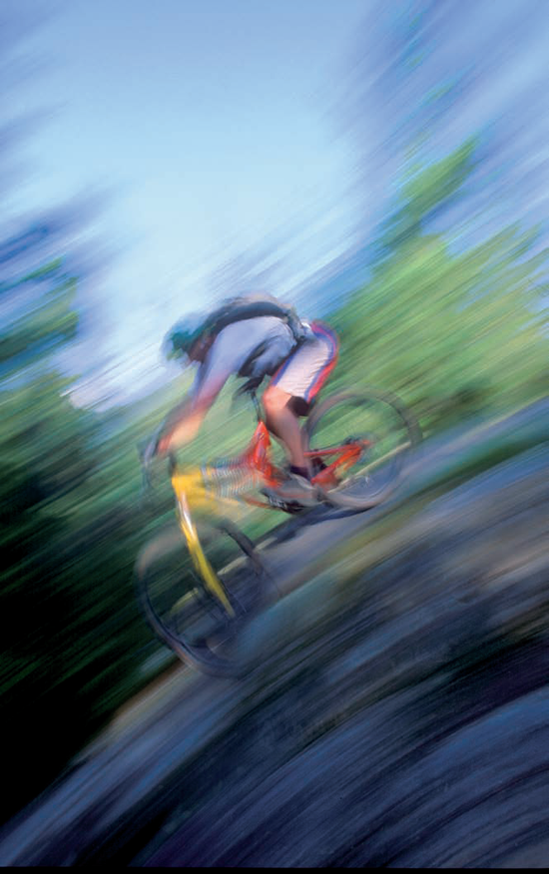
"Bike Blur"
© Greg Eymundson
Whistler, British Columbia, Canada www.insight-photography.com
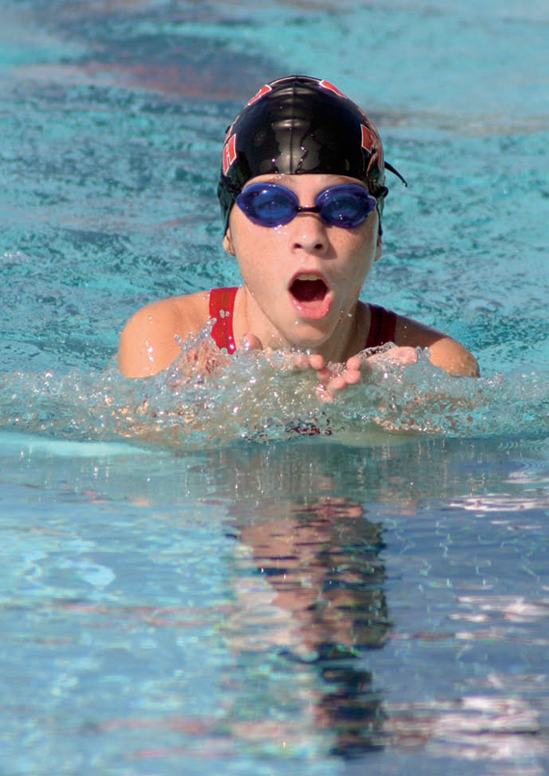
"Cory 4"
© Bernie Cory
Chesapeake, Virginia
Sporting events held outdoors offer natural light that can give a photographer more flexibility in the aperture and shutter speed. And having this flexibility can free you up to capture fleeting moments like this one where the swimmer briefly came up for air. The subject fills the frame very nicely, and the photographer even managed to capture her reflection in the water below. Finding the right vantage point from which to shoot is important before the action takes place, and clicking the shutter a split second before the moment occurs is also imperative.
"My three kids are my favorite subjects, and I enjoy taking pictures at their events. On this gorgeous day in October, Maggie had a swim meet. The event was originally scheduled for indoors, but because the weather was so nice, they decided to move it to the outdoor pool. Taking pictures at a swim meet is very difficult because the kids spend most of their time underwater. I was determined to get a shot by timing her breast stroke and getting into the same rhythm. When she popped her head out of the water, I was able to grab the shot. The sun was at a perfect angle to give me a great reflection of Maggie in the water. It also made the water sparkle as her hands came out of the water."
Canon EOS Digital Rebel
Quantaray AF 70–300mm zoom lens set at 300mm
1/2500 of a second at f/7.1
ISO 400
Daylight
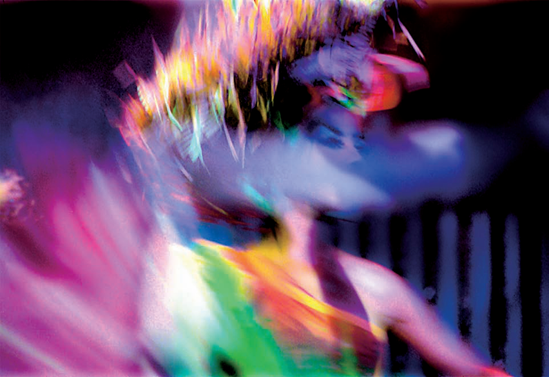
"Tropicana Dreams"
© C.J. Groth
Key West, Florida www.keywestphotos.com
This impressionistic image shows us the swirling excitement and color of a stage show. You can deliberately blur motion in your photographs by using a slow shutter speed, which enables you to convey a real sense of motion in your images. The slower the shutter speed, the greater the amount of blur, so try using shutter speeds of1/30 or slower. You are likely to get a little camera movement when handholding your camera, which also contributes to a blurred image. And as you can see in this example, a brightly lit subject appears even more blurred because the highlights tend to spread. The bright colors are especially striking against the darkness.
"'Tropicana Dreams' was taken at the floor show at the Hotel Nacional de Cuba in Havana. The dancers were glorious and I wanted to capture the energy of the scene before me. I was sitting at a table close to the stage, and I manually pre-focused on a bright area through which the dancers moved (most of the stage was quite dark). I planted my elbows firmly on the table to form a tripod with my body, and watched through the viewfinder, squeezing the shutter when a dancer whirled through my pre-focused area. I don't know the shutter speed, but it was obviously quite slow. This photo was the most abstract of the series and I think it's the most beautiful."
Canon EOS A2e 35mm SLR
Canon 28–105mm zoom lens set at 105mm
Fuji NGH 800 color negative film
Shot in program mode
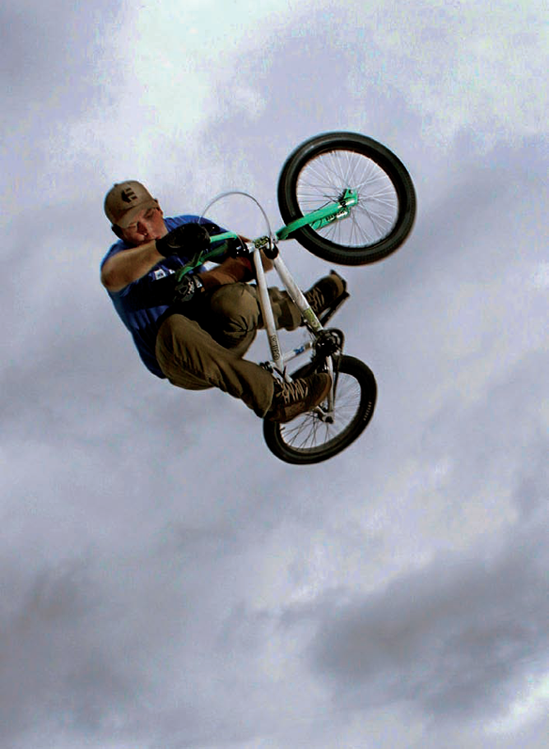
"Taj Mihelich-Austin, TX"
© J. Dennis Thomas
Austin, Texas http://deadsailorproductions.com
By using flash, this photographer was able to solve the problems of a slow shutter speed caused by the dull light of an overcast day and the dim light on the subject. Flash is a great tool for recording moving objects sharply, as long as they're within range of the flash. And in a case like this, where the photographer was working with the bicyclist one on one, using flash worked great. But don't use it at events where it would distract athletes or performers.
"I was doing a photo shoot with professional BMX rider, Taj Mihelich, at the ramp behind his office. Because the day was overcast, I was having a problem keeping the shutter speed fast enough to freeze the action while still maintaining a small enough aperture to ensure that the entire bike was in focus. By boosting my ISO, I was able to get the exposure that I needed, but I was unhappy with the soft lighting from the overcast sky. To remedy the flat lighting, I placed a Canon 580EX flash on a stand to the right of the camera and aimed it in the general direction where Taj would be when doing the trick. I used a Canon ST-E2 remote commander to trigger the off-camera flash. The flash provided just enough light to separate Taj from the overcast sky behind him."
Canon EOS 30D digital SLR
Canon EF-S 18–55mm 1:3.5–5.6 zoom lens set at 18mm
1/200 of a second at f/7.1
ISO 400
Canon Speedlite 580EX flash and Canon Speedlite Transmitter ST-E2
This photographer caught the perfect moment of a cowboy suspended just above the ground after unfortunately being bucked off a bull. (The photo title is especially appropriate.) Although action often happens too quickly for the human eye to perceive the details clearly, you can capture the instant in a click of the shutter at the right time. This image also tells a story about the event and reveals its spirit. A good motor drive is handy for firing several frames per second in rapid succession. You might also try using the sports mode on your camera, which performs a similar function. A fast shutter speed is always essential for stopping action, and because the arena was poorly lit, the photographer used a very fast ISO of 3200. Although this photographer used a telephoto lens to bring the scene in close, the sense of the western atmosphere is still very apparent.
"I had the chance to shoot at this rodeo, but had never photographed a rodeo before. This photo was taken in a very poorly lit arena, and because I had no access to strobes, I used a high ISO rating. I was amazed at the raw power of the bulls, and wanted to try to capture that violent power."
Canon EOS 1D Mark II digital SLR
Canon EF 300mm f/2.8 telephoto lens
1/500 of a second at f/2.8
ISO 3200
Ambient, interior light
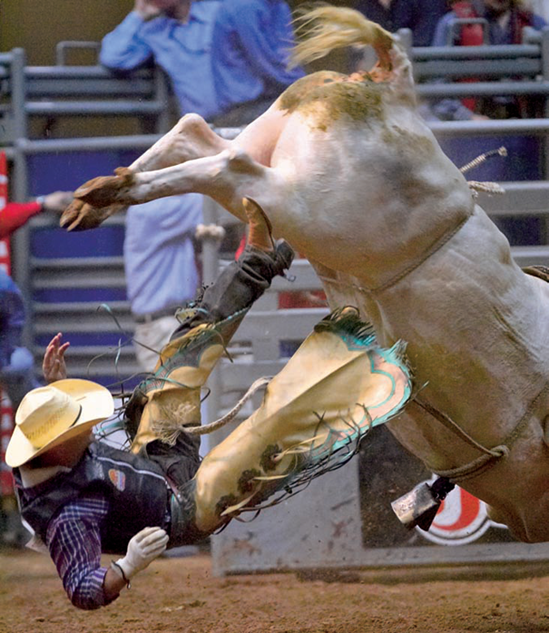
"Ouch"
© Chris Anderson
Waco, Texas www.candcphotography.net
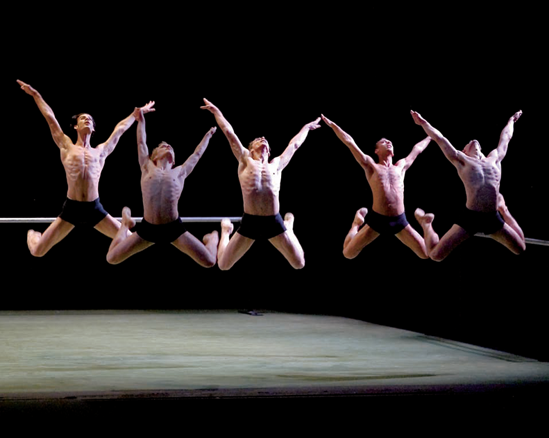
"Jump"
© Sharen Bradford
Dallas, Texas www.thedancingimage.com
This is a great example of a decisive moment frozen in time. Good indoor action photos demand a lot photographically. In most cases, you have to work with the ambient stage lights which means more wide-open apertures, a high ISO, and a fast telephoto lens. Your timing and technique is crucial to getting great images. Most cameras have a continuous-focusing feature that allows you to follow and focus on the action as it occurs. And, because there's such a discrepancy between the lights on the performers and the dimly lit background, use spot metering on your subjects.
"This was taken during a live performance of 'Sextet' by Ballet Biarritz. The stage was framed by ballet barres to suggest a dance studio, and the photograph was made using available stage light. The dancers' incredible technique, combined with their long hours of rehearsal, provided the perfect moment in time. My past dance training has given me the ability to anticipate action, and I typically shoot with a shutter speed of at least 1/125 to capture the motion. Stage lighting for dance is unpredictable and often very dim. Depth of field, even at ISO 1600, usually ranges from f/2.8 to f/5.6. My personal preference is to shoot for stopped motion/peak action, rather than for great depth of field. Photographing dancers in performance is my passion."
Canon EOS 1D digital SLR
Canon EF 70–200mm f/2.8L zoom lens set at 150mm
Shutter priority
1/125 of a second at f/2.8
ISO 1600
Ambient stage lighting
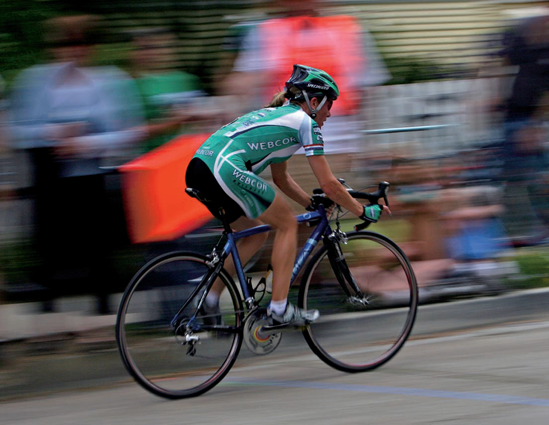
"Pro Rider"
© Kurt Harvey
Sunnyvale, California
A relatively sharp subject against a blurred background also conveys the feeling of speed. To produce this effect, you need to follow the subject with your camera in one smooth movement during the exposure. This technique is known as panning. As shown by the image of this bicyclist, panning focuses the viewer's attention on the subject and renders the background as a soft, colorful blur. It takes a lot of experimenting to do panning successfully and the results aren't always predictable. You must stand firmly and look through the viewfinder while twisting your upper body in the direction of the moving subject. It takes practice, but in time, you can release the shutter smoothly and avoid jarring the camera.
"This was the first professional criterium bicycle race I've attended. I was amazed at the skill and tenacity of the riders as they powered around the hilly course for over an hour at maximum speed, charging toward me and then passing by in a whirl of air and a hum of tires — gone in a flash."
Canon EOS 20D digital SLR
Canon EF 70–200mm f/2.0 L IS zoom lens set at 70mm
1/50 of a second at f/14
ISO 100
Ambient daylight
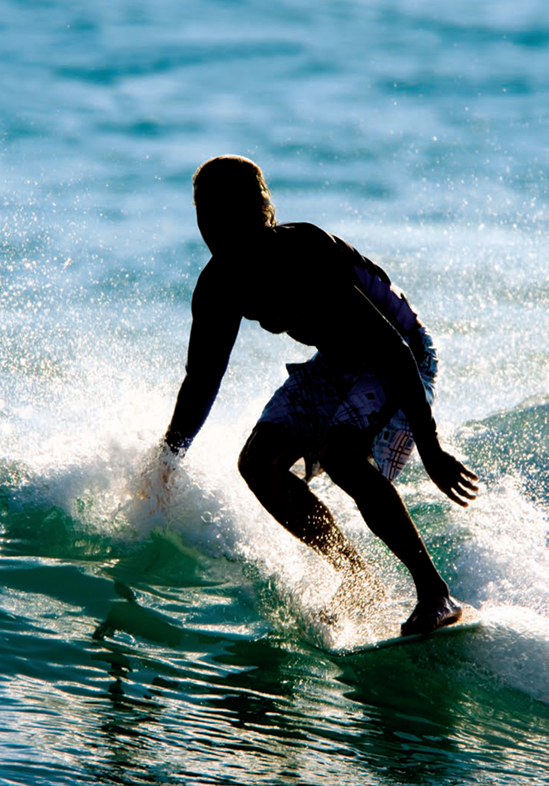
"Surfer Silhouette"
© Jerome Judge
Jupiter, Florida
Great timing and excellent framing are two very successful elements in this surfing photo. And the backlighting has created a silhouette, a great technique when you want to emphasize a shape and obscure details. You can do this by exposing for the bright background, allowing the subject to become dark. By rendering his subject in silhouette, the photographer emphasizes the drama of surfing. To choose a suitable subject for a silhouette, you want to pick a simple, easily recognizable shape.
Whenever you shoot into a light source, try not to include it in the picture because you get lens flare, which are the washed-out squares of light created when the sun's rays bounce off the lens's optical elements. Keep the light source outside the frame or use a lens hood, which guards against flare and offers some protection to the lens. The photographer also brought the action in close by using a telephoto lens coupled with a teleconverter.
"I was attending the annual Jupiter International Surfing Contest here in Jupiter, Florida. It was early morning and the sun was behind the surfers, so it was ideal lighting conditions for a silhouette. I metered the water behind the surfer and fired away. This turned out to be a great shot; one that almost jumps off the page with energy."
